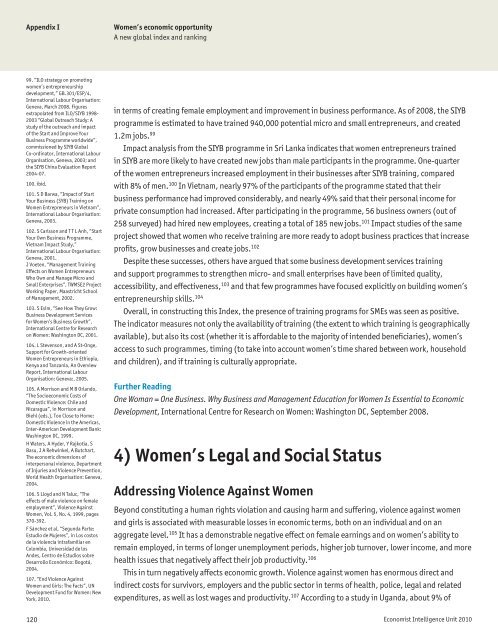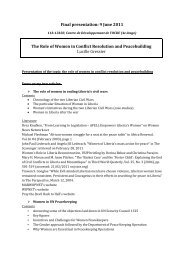Women's Economic Opportunity Index - Economist Intelligence Unit
Women's Economic Opportunity Index - Economist Intelligence Unit
Women's Economic Opportunity Index - Economist Intelligence Unit
- No tags were found...
You also want an ePaper? Increase the reach of your titles
YUMPU automatically turns print PDFs into web optimized ePapers that Google loves.
Appendix IWomen’s economic opportunityA new global index and ranking99. “ILO strategy on promotingwomen’s entrepreneurshipdevelopment,” GB.301/ESP/4,International Labour Organisation:Geneva, March 2008. Figuresextrapolated from ILO/SIYB 1998-2003 “Global Outreach Study: Astudy of the outreach and impactof the Start and Improve YourBusiness Programme worldwide”,commissioned by SIYB GlobalCo-ordinator, International LabourOrganisation, Geneva, 2003; andthe SIYB China Evaluation Report2004-07.100. ibid.101. S D Barwa, “Impact of StartYour Business (SYB) Training onWomen Entrepreneurs in Vietnam”,International Labour Organisation:Geneva, 2003.102. S Carlsson and T T L Anh, “StartYour Own Business Programme,Vietnam Impact Study,”International Labour Organisation:Geneva, 2001.J Voeten, “Management TrainingEffects on Women EntrepreneursWho Own and Manage Micro andSmall Enterprises”, TWMSE2 ProjectWorking Paper, Maastricht Schoolof Management, 2002.103. S Esim, “See How They Grow:Business Development Servicesfor Women’s Business Growth”,International Centre for Researchon Women: Washington DC, 2001.104. L Stevenson, and A St-Onge,Support for Growth-orientedWomen Entrepreneurs in Ethiopia,Kenya and Tanzania, An OverviewReport, International LabourOrganisation: Geneva:, 2005.105. A Morrison and M B Orlando,“The Socioeconomic Costs ofDomestic Violence: Chile andNicaragua”, in Morrison andBiehl (eds.), Too Close to Home:Domestic Violence in the Americas,Inter-American Development Bank:Washington DC, 1999.H Waters, A Hyder, Y Rajkotia, SBasu, J A Rehwinkel, A Butchart,The economic dimensions ofinterpersonal violence, Departmentof Injuries and Violence Prevention,World Health Organisation: Geneva,2004.106. S Lloyd and N Taluc, “Theeffects of male violence on femaleemployment”, Violence AgainstWomen, Vol. 5, No. 4, 1999, pages370-392.F Sánchez et al, “Segunda Parte:Estudio de Mujeres”, in Los costosde la violencia intrafamiliar enColombia, Universidad de losAndes, Centro de Estudios sobreDesarrollo Económico: Bogotá,2004.107. “End Violence AgainstWomen and Girls: The Facts”, UNDevelopment Fund for Women: NewYork, 2010.in terms of creating female employment and improvement in business performance. As of 2008, the SIYBprogramme is estimated to have trained 940,000 potential micro and small entrepreneurs, and created1.2m jobs. 99Impact analysis from the SIYB programme in Sri Lanka indicates that women entrepreneurs trainedin SIYB are more likely to have created new jobs than male participants in the programme. One-quarterof the women entrepreneurs increased employment in their businesses after SIYB training, comparedwith 8% of men. 100 In Vietnam, nearly 97% of the participants of the programme stated that theirbusiness performance had improved considerably, and nearly 49% said that their personal income forprivate consumption had increased. After participating in the programme, 56 business owners (out of258 surveyed) had hired new employees, creating a total of 185 new jobs. 101 Impact studies of the sameproject showed that women who receive training are more ready to adopt business practices that increaseprofits, grow businesses and create jobs. 102Despite these successes, others have argued that some business development services trainingand support programmes to strengthen micro- and small enterprises have been of limited quality,accessibility, and effectiveness, 103 and that few programmes have focused explicitly on building women’sentrepreneurship skills. 104Overall, in constructing this <strong>Index</strong>, the presence of training programs for SMEs was seen as positive.The indicator measures not only the availability of training (the extent to which training is geographicallyavailable), but also its cost (whether it is affordable to the majority of intended beneficiaries), women’saccess to such programmes, timing (to take into account women’s time shared between work, householdand children), and if training is culturally appropriate.Further ReadingOne Woman = One Business. Why Business and Management Education for Women Is Essential to <strong>Economic</strong>Development, International Centre for Research on Women: Washington DC, September 2008.4) Women’s Legal and Social StatusAddressing Violence Against WomenBeyond constituting a human rights violation and causing harm and suffering, violence against womenand girls is associated with measurable losses in economic terms, both on an individual and on anaggregate level. 105 It has a demonstrable negative effect on female earnings and on women’s ability toremain employed, in terms of longer unemployment periods, higher job turnover, lower income, and morehealth issues that negatively affect their job productivity. 106This in turn negatively affects economic growth. Violence against women has enormous direct andindirect costs for survivors, employers and the public sector in terms of health, police, legal and relatedexpenditures, as well as lost wages and productivity. 107 According to a study in Uganda, about 9% of120 <strong>Economist</strong> <strong>Intelligence</strong> <strong>Unit</strong> 2010




